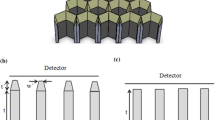Abstract.
The imaging properties of optimally designed planar-concave (PC) collimators were evaluated by means of Monte Carlo simulations. The evaluation was done with respect to total system spatial resolution and the overall image noise distribution in single-photon emission tomography. The results showed that the non-isotropy with PC collimators, assessed by the ratio of the full-width at half-maximum in the radial and tangential directions, was reduced by about 60% as compared with a conventional parallel-hole collimator for sources located 200 mm away from the centre of rotation. Furthermore, the image noise distribution along the object radius became more uniform when the curved collimator was used. The maximum increase in noise due to use of the curved collimator was about 45% close to the edge of the phantom, where the hole length was about 3 times longer. We also showed with Monte Carlo simulations that the spatial resolution of the lateral cortex when using the curved collimator was significantly improved due to improved radial resolution.
Similar content being viewed by others
Author information
Authors and Affiliations
Additional information
Received 1 May and in revised form 4 August 1997
Rights and permissions
About this article
Cite this article
Kimiaei, S., Ljungberg, M. & Larsson, S. Evaluation of optimally designed planar-concave collimators in single-photon emission tomography. Eur J Nucl Med 24, 1398–1404 (1997). https://doi.org/10.1007/s002590050166
Issue Date:
DOI: https://doi.org/10.1007/s002590050166




